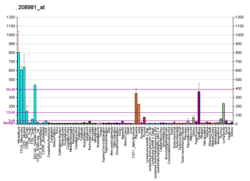PECAM1
Le PECAM1 (pour « Platelet endothelial cell adhesion molecule ») ou CD31 est une protéine de type cluster de différenciation dont le gène est PECAM1 situé sur le chromosome 17 humain.
Rôles
[modifier | modifier le code]Son poids moléculaire est de 130 kDa[5]. Il s'agit d'une protéine transmembranaire avec une partie extracellulaire composée de six domaines de type immunoglobuline, une partie transmembranaire et une partie cytoplasmique[6], cette dernière comportant un domaine de type inhibiteur de tyrosine kinase[7]. Il est exprimé à la surface des cellules endothéliales, des cellules hématopoïétiques, des lymphocytes et des cellules dendritiques[7]. Il joue un rôle dans la régulation de l'inflammation[8]. Dans la plaque d'athérome, il inhibe la formation d'une thrombose[9].
Exprimé dans les jonctions intercellulaires, il est lié à la vimentine[10]. Il agit comme un capteur de cisaillement au niveau de la paroi des artérioles : en cas de déformation de cette dernière[11], la protéine est phosphorylée[12] et active le système Akt et la NO synthase[13] permettant la production du monoxyde d'azote (NO) entraînant une vasodilatation.
Il pourrait jouer un rôle dans la genèse de l'athérome[14] mais cette action est variable suivant le site artériel concerné[15]. Il pourrait intervenir dans la genèse d'un anévrisme de l'aorte abdominale[16]. Dans l'angine de poitrine, son expression est augmentée, et diminuée transitoirement en cas de syndrome coronarien aigu[17].
Le MMP9 dégrade la partie extracellulaire du CD31[18] en coupant les cinq premiers domaines de type immunoglobuline[19], inhibant l’activité de la protéine.
Notes et références
[modifier | modifier le code]- GRCh38: Ensembl release 89: ENSG00000261371 - Ensembl, May 2017
- GRCm38: Ensembl release 89: ENSMUSG00000020717 - Ensembl, May 2017
- ↑ « Publications PubMed pour l'Homme », sur National Center for Biotechnology Information, U.S. National Library of Medicine
- ↑ « Publications PubMed pour la Souris », sur National Center for Biotechnology Information, U.S. National Library of Medicine
- ↑ Newman PJ, Switched at birth: a new family for PECAM-1, J Clin Invest, 1999;103:5–9
- ↑ Newman PJ, Newman DK, Signal transduction pathways mediated by PECAM-1: new roles for an old molecule in platelet and vascular cell biology, Arterioscler Thromb Vasc Biol, 2003;23:953–964
- Marelli-Berg FM, Clement M, Mauro C, Caligiuri G, An immunologist's guide to CD31 function in T-cells, J Cell Sci, 2013;126:2343–2352
- ↑ Privratsky JR, Newman DK, Newman PJ, PECAM-1: conflicts of interest in inflammation, Life Sci, 2010;87:69–82
- ↑ Caligiuri G, Groyer E, Khallou-Laschet J et al. Reduced immunoregulatory CD31+ T cells in the blood of atherosclerotic mice with plaque thrombosis, Arterioscler Thromb Vasc Biol, 2005;25:1659–1664
- ↑ Conway DE, Breckenridge MT, Hinde E, Gratton E, Chen CS, Schwartz MA, Fluid shear stress on endothelial cells modulates mechanical tension across VE-cadherin and PECAM-1, Curr Biol, 2013;23:1024–1030
- ↑ Bagi Z, Frangos JA, Yeh JC, White CR, Kaley G, Koller A, PECAM-1 mediates NO-dependent dilation of arterioles to high temporal gradients of shear stress, Arterioscler Thromb Vasc Biol, 2005;25:1590–1595
- ↑ Wang S, Iring A, Strilic B et al. P2Y2 and Gq/G11 control blood pressure by mediating endothelial mechanotransduction, J Clin Invest, 2015;125:3077-3086
- ↑ Fleming I, Fisslthaler B, Dixit M, Busse R, Role of PECAM-1 in the shear-stress-induced activation of Akt and the endothelial nitric oxide synthase (eNOS) in endothelial cells, J Cell Sci, 2005;118(pt 18):4103–4111
- ↑ Harry BL, Sanders JM, Feaver RE et al. Endothelial cell PECAM-1 promotes atherosclerotic lesions in areas of disturbed flow in ApoE-deficient mice, Arterioscler Thromb Vasc Biol, 2008;28:2003–2008
- ↑ Goel R, Schrank BR, Arora S et al. Site-specific effects of PECAM-1 on atherosclerosis in LDL receptor-deficient mice, Arterioscler Thromb Vasc Biol, 2008;28:1996–2002
- ↑ Caligiuri G, Rossignol P, Julia P et al. Reduced immunoregulatory CD31+ T cells in patients with atherosclerotic abdominal aortic aneurysm, Arterioscler Thromb Vasc Biol, 2006;26:618–623
- ↑ Flego D, Severino A, Trotta F et al. Altered CD31 expression and activity in helper T cells of acute coronary syndrome patients, Basic Res Cardiol, 2014;109:448
- ↑ Kato H, Kuriyama N, Duarte S, Clavien PA, Busuttil RW, Coito AJ, Mmp-9 deficiency shelters endothelial pecam-1 expression and enhances regeneration of steatotic livers after ischemia and reperfusion injury, J Hepatol, 2014;60:1032–1039
- ↑ Angelini G, Flego D, Vinci R et al. Matrix metalloproteinase-9 might affect adaptive immunity in non-ST segment elevation acute coronary syndromes by increasing CD31 cleavage on CD4+ T-cell, Eur Heart J, 2018;39:1089–1097







